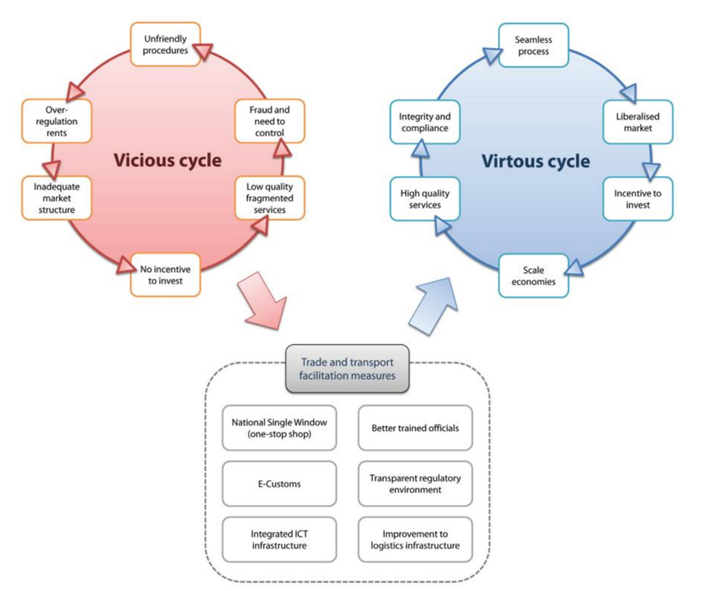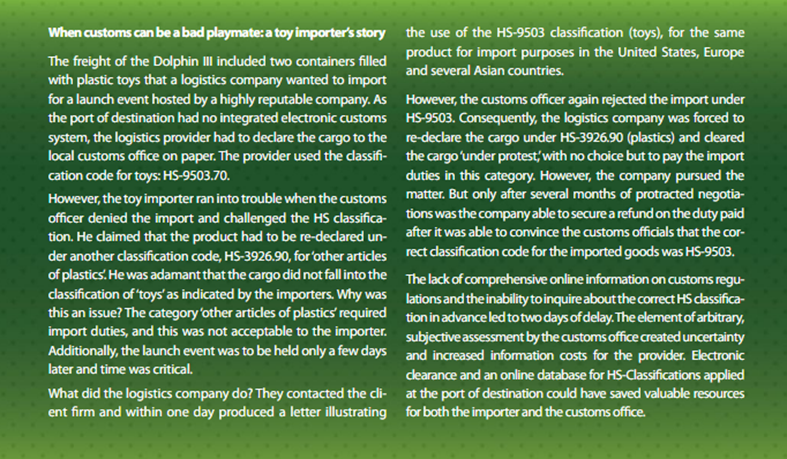
President Trump has killed the Trans-Pacific Partnership Agreement (TPP) and is looking to re-negotiate the North America Free Trade Agreement (NAFTA). Since his electoral campaign, President Trump decried the loss of manufacturing jobs and blamed it
on China, from currency manipulation to unfair trading practices. On the other side of the Atlantic, British Prime Minister Theresa May is attempting to figure out the details of Brexit out of the European Union (EU). Her path to achieving a proposed
sectoral customs deal is fraught with legal, technical, and political complications as Financial Times reported.
With these developments in the backdrop, we wanted to understand trade processes and the government's role in facilitating trade. We revisited the Lee Kuan Yew School's Asia Trends Monitoring report, Welcome to the trade game to glean insights on the inner workings of trade facilitation in the context of the Association of Southeast Asian Nations (ASEAN).
Tradetransaction costs
According to the report, while improvements to transport and communication infrastructure have significantly reduced costs for trade within ASEAN countries over the last two decades, progress in recent years and in particular in so called soft trade facilitation
measures (such as level of customs efficiency, regulatory environment, and government transparency) has been meagre.
Beyond the elimination of import duties or tariff barriers, the region still faces a number of impediments to trade that have enjoyed less attention in international discussions. These include inefficient customs procedures, substandard quality of port
and airport infrastructure, and untransparent regulatory frameworks together drive up Trade Transaction Costs (TCCS) and form serious impediments to freer trade flows. Transaction costs arise at every step of the trading process and capture commercial,
financial, transport, and regulatory processes (see Figure 1).
Figure 1: Components of Trade Transaction Costs

According to estimates by the United Nations Conference on Development (UNCTAD) the average customs transaction involves 20-30 different parties, 40 documents, 200 data elements (30 of which are at least repeated 30 times) and duplicate entry of 60-70
% of all data. Direct and indirect costs associated with such procedures are estimated to be about 7-10 % of the value of global trade. The time required to prepare the customs documentation within ASEAN and proceed with the import can be as little
as 4 days in Singapore or as long as 50 days in Lao PDR. This extreme variance poses one of the biggest challenges to the ambitious goal of the free movement of goods between Southeast Asian nations as part of the AEC by 2015, and is seen as a major
impediment to further gains from trade liberalization. A study by the Asia-Pacific Economic Cooperation (APEC), for example, estimates that a reduction of merely 5 % in trade transaction costs can cause an increase of 0.9 % in GDP for APEC countries.
Trade facilitation
The Organisation for Economic Co-operation and Development (OECD) defines trade facilitation as the simplification and standardization of procedures and associated information flows required to move goods internationally from seller to buyer and to pass
payments in the other direction. Trade facilitation can be grouped into hard and soft infrastructure. The former includes the development and quality of the physical infrastructure (e.g. ports, cargo terminals, airport capacity) and the application
of Information and Communication Technology (ICTs) to the extent that they reduce transaction costs. The latter comprises border and transport efficiency as well as the business and regulatory environment.
Trade facilitation represents a win-win situation for governments, businesses, and consumers. The highest benefits are to be expected in countries with the lowest level of efficiency and substandard infrastructure (such as ports and inland connectivity).
Obstacles to trade that should be targeted through policy interventions include slow port landing and handling, poor governance, unofficial payments, and high freight costs. Discretionary powers that allow for rent seeking activities by officials, information
asymmetries and institutional bottlenecks (administrative, legal, financial, regulatory, and other logistics infrastructure) impose additional costs. There is also room for domestic policy reform to achieve broader benefits in areas such as, competition
policy, harmonization, standardization, and transparency. Embedded in reforms tackling the above issues, trade and transport facilitation policies can help transform the trade process from a vicious circle into a virtuous circle (see Figure 2).
Figure 2: From a vicious to a virtuous cycle

Graph based on Arvis J., et al. (2007). The Cost of Being Landlocked: Logistics Costs and Supply Chain Reliability. Policy Research Working Paper 4258. Washington DC, World Bank: 63
Intervention strategies
Points of intervention for policy makers should focus on increasing customs efficiency and thus lowering the trade transaction costs for importing and exporting firms alike. Moreover, empowering more SMEs to become exporters and broadening their access
to trade finance can make a significant contribution to the provision of employment and ultimately also poverty reduction.
SME Centres
Government Financial Institutions, commercial banks and non-governmental organisations should cooperate in building a network of regional centres equipped with up-to-date ICT technology and staffed with knowledgeable staff. The centres will provide advice
on financing facilities available in the respective country and offer capacity-building courses for small businesses. The training portfolio should range from basic ICT familiarisation, through management skills to specialized information on export-import
regulations. A pilot phase in representative locations could be used to identify the most common deficiencies and help adjust the SME centre design before scaling the model to the whole country.
Customs modernisation
Due to the rapid integration of networked information technology in almost all aspects of the international supply chain, ICT, infrastructure, and services are frequently mentioned as important facilitators of trade. While the implementation of e-Customs
services can greatly reduce time and documentation required for customs clearance, it has to be accompanied by further measures. Customs officers need to be trained in the application of the newly introduced ICTs to ensure that cumbersome paper documentation
can be completely replaced. In light of the 2015 deadline for the ASEAN Single Window all border agencies involved in export and import procedures have to be involved in a concerted reform effort to harmonize the data requirements and bring down the
overall number of data points to complete the clearance process. As the case of Thailand illustrates, the savings in trade costs can be enormous.

This article is based onthe Lee Kuan Yew School's Asia Trends Monitoring report, Welcome to the trade game (2011).